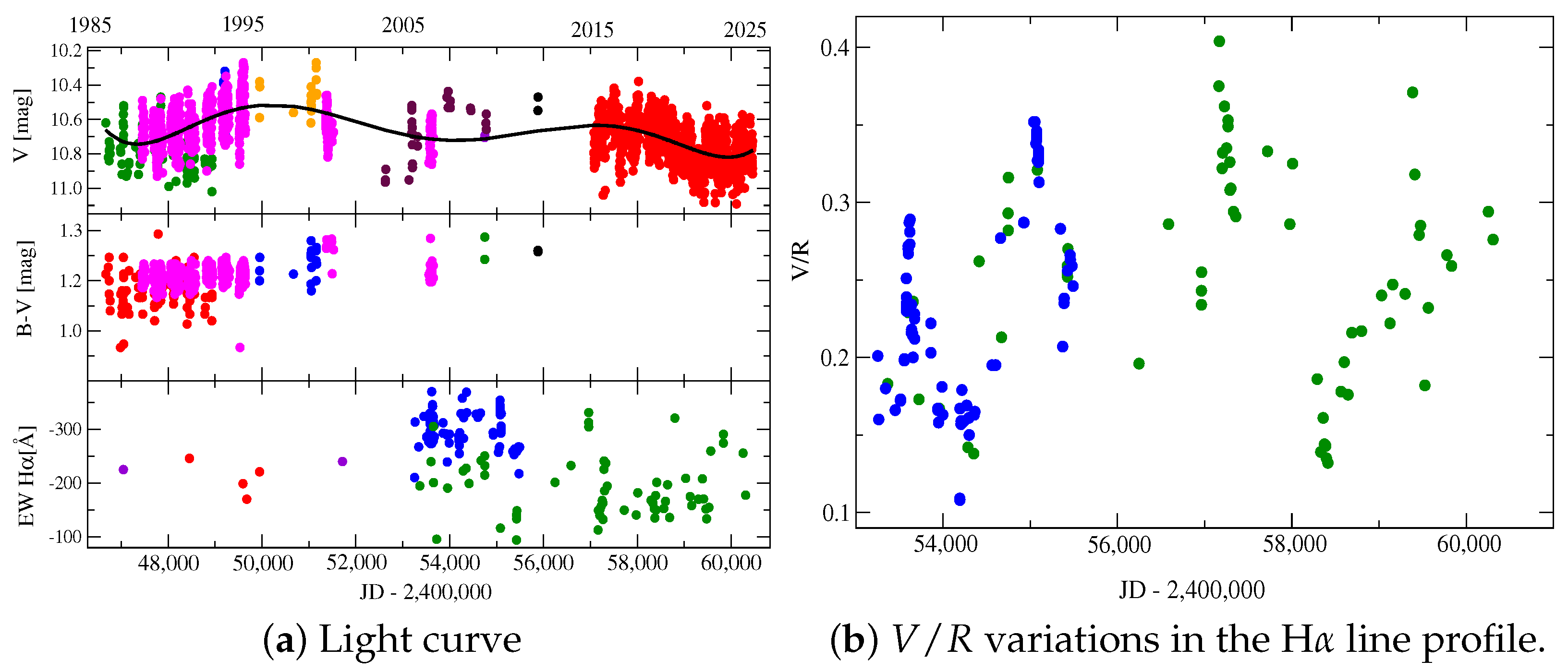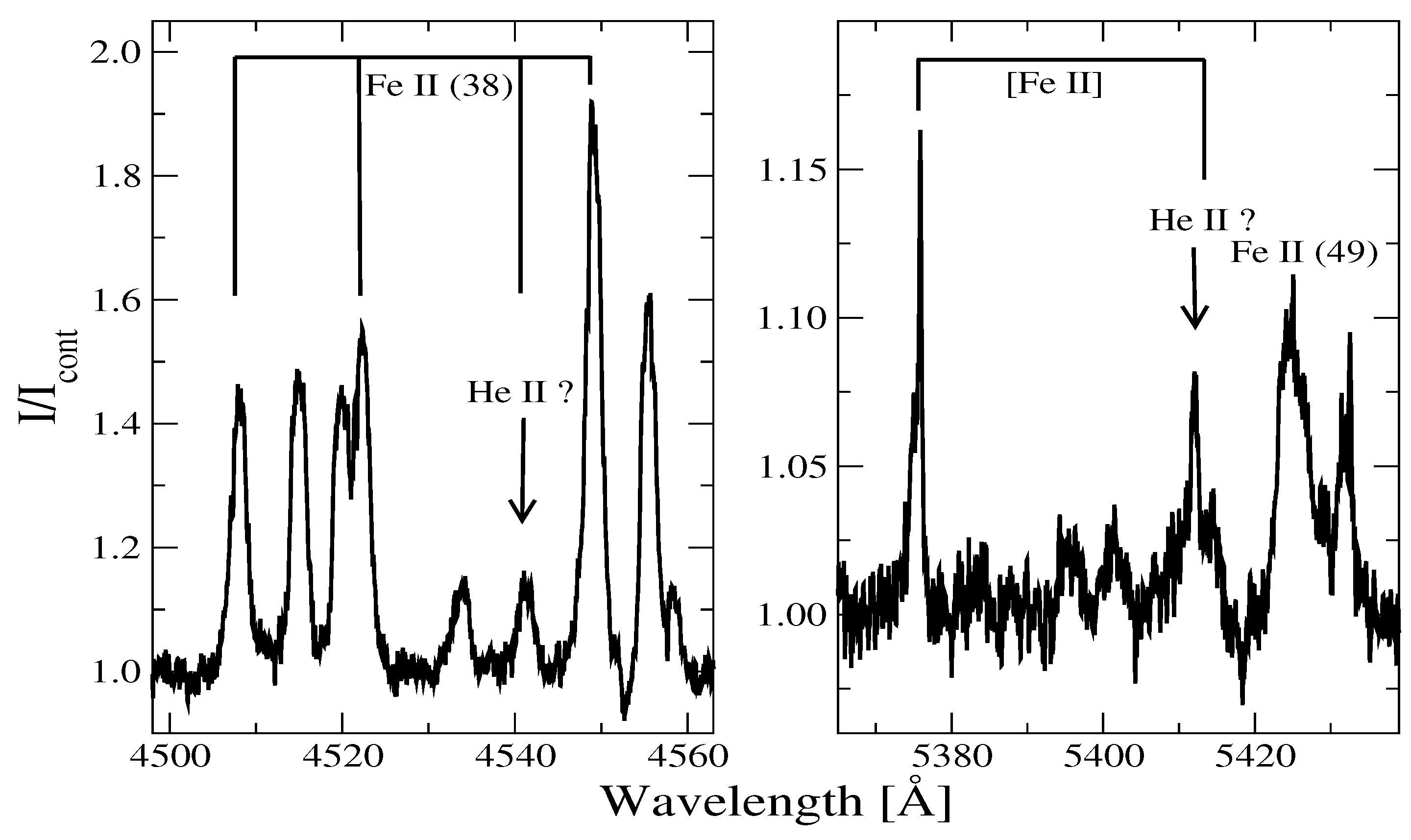A Spectroscopic and Photometric Study of MWC 342 and Its B[e] Phenomenon over the Last 40 Years
Abstract
1. Introduction
2. Observations
| Observatory | Dates | Telescope/Spectrograph/Location | R | Range (Å) | # sp. | Ref |
|---|---|---|---|---|---|---|
| Mauna Kea | 2004–2022 | 3.6 m, CFHT, ESPaDoNs, Hawaii | 65,000 | 3800–10,500 | 10 | [16] |
| OAN SPM | 2005–2019 | 2 m, REOSC, Baja California, Mexico | 18,000 | 3700–7300 | 14 | [17] |
| McD | 2005–2012 | 2.7 m, Texas, USA | 60,000 | 3700–10,500 | 2 | [18] |
| Pic du Midi | 2007 | 2 m, NARVAL, France | 65,000 | 3700–10,500 | 1 | [19] |
| Indian Astron. Obs. | 2018–2019 | 2 m, HCT, Hanle, India | 25,000 | 4200–10,500 | 4 | [20] |
| ORLM | 2010–2021 | 1.2 m, HERMES, La Palma, Spain | 85,000 | 3800–9,000 | 30 | [21] |
| Apache Point | 2021–2023 | 3.5 m, ARCES, New Mexico, USA | 31,500 | 3600–10,500 | 2 | [22] |
| TCO | 2023 | 0.81 m, Eshel, North Carolina, USA | 12,000 | 3800–7800 | 2 | [23] |
| Observatory | Dates | Telescope/Location | Filters | # | Ref |
|---|---|---|---|---|---|
| Majdanak | 1984–1999 | 0.6 m, Uzbekistan | 774 | [15] | |
| Assy-Turgen | 1986–1994 | 1.0 m, Kazakhstan | 46 | [7,9] | |
| TShAO | 1995–1999 | 1.0 m, Kazakhstan | 16 | [9] | |
| INTEGRAL | 2002–2008 | , space | V | 28 | [24] |
| Abastumani | 1989–1993 | 1.25 m, Georgia | 48 | [25] | |
| APAS DR10 | 2011 | multiple telescopes | 2 | [26] | |
| ASAS-SN | 2015–2024 | multiple telescopes | 1178 | [27,28] |
3. Results and Discussion
3.1. Variability
3.2. Extinction, Distance, and Luminosity
3.3. Spectral Features
4. Conclusions
Author Contributions
Funding
Data Availability Statement
Acknowledgments
Conflicts of Interest
Abbreviations
References
- Merrill, P.W.; Burwell, C.G. Catalogue and Bibliography of Stars of Classes B and A whose Spectra have Bright Hydrogen Lines. Astrophys. J. 1933, 78, 87. [Google Scholar] [CrossRef]
- Swings, V.P.; Struve, O. Spectrographic Observations of Peculiar Stars. Astrophys. J. 1943, 97, 194. [Google Scholar] [CrossRef][Green Version]
- Geisel, S.L. Infrared Excesses, Low-Excitation Emission Lines, and Mass Loss. Astrophys. J. 1970, 161, L105. [Google Scholar] [CrossRef]
- Allen, D.A.; Swings, J.P. The spectra of peculiar Be star with infrared excesses. Astron. Astrophys. 1976, 47, 293–302. [Google Scholar]
- Brosch, N.; Leibowitz, E.M.; Spector, N. The emission-line spectrum of MWC 342 in 1974 - 1975. Astron. Astrophys. 1978, 65, 259–263. [Google Scholar]
- Arkhipova, V.P.; Ipatov, A.P. Spectrophotometry of three peculiar emission-line stars. Sov. Astron. Lett. 1982, 8, 298–302. [Google Scholar]
- Bergner, Y.K.; Miroshnichenko, A.S.; Sudnik, I.S.; Yudin, R.V.; Yutanov, N.Y.; Krivtsov, A.A.; Sokolov, A.N.; Kuratov, K.S.; Mukanov, D.V. MWC:324—A Young Star. Astrophysics 1990, 32, 109. [Google Scholar] [CrossRef]
- Lamers, H.J.G.L.M.; Zickgraf, F.J.; de Winter, D.; Houziaux, L.; Zorec, J. An improved classification of B[e]-type stars. Astron. Astrophys. 1998, 340, 117–128. [Google Scholar]
- Miroshnichenko, A.; Corporon, P. Revealing the nature of the B[e] star MWC 342. Astron. Astrophys. 1999, 349, 126–134. [Google Scholar]
- Miroshnichenko, A.S. Toward Understanding the B[e] Phenomenon. I. Definition of the Galactic FS CMa Stars. Astrophys. J. 2007, 667, 497–504. [Google Scholar] [CrossRef][Green Version]
- Lebzelter, T.; Mowlavi, N.; Lecoeur-Taibi, I.; Trabucchi, M.; Audard, M.; García-Lario, P.; Gavras, P.; Holl, B.; Jevardat de Fombelle, G.; Nienartowicz, K.; et al. Gaia Data Release 3. The second Gaia catalogue of long-period variable candidates. Astron. Astrophys. 2023, 674, A15. [Google Scholar] [CrossRef]
- Zickgraf, F.J. Kinematical structure of the circumstellar environments of galactic B[e] -type stars. Astron. Astrophys. 2003, 408, 257–285. [Google Scholar] [CrossRef]
- Kučerová, B.; Korčáková, D.; Polster, J.; Wolf, M.; Votruba, V.; Kubát, J.; Škoda, P.; Šlechta, M.; Křížek, M. Time-dependent spectral-feature variations of stars displaying the B[e] phenomenon. II. MWC 342. Astron. Astrophys. 2013, 554, A143. [Google Scholar] [CrossRef]
- Bergner, Y.K.; Miroshnichenko, A.S.; Yudin, R.V.; Kuratov, K.S.; Mukanov, D.B.; Shejkina, T.A. Observations of emission-line stars with IR excesses. II. Multicolor photometry of B[e] stars. Astron. Astrophys. Suppl. Ser. 1995, 112, 221. [Google Scholar]
- Herbst, W.; Shevchenko, V.S. A Photometric Catalog of Herbig AE/BE Stars and Discussion of the Nature and Cause of the Variations of UX Orionis Stars. Astron. J. 1999, 118, 1043–1060. [Google Scholar] [CrossRef]
- Manset, N.; Donati, J.F. ESPaDOnS: An exhelle spectro-polarimetric device for the observation of stars. In Polarimetry in Astronomy; Fineschi, S., Ed.; Society of Photo-Optical Instrumentation Engineers (SPIE) Conference Series; SPIE: Bellingham, WA, USA, 2003; Volume 4843, pp. 425–436. [Google Scholar] [CrossRef]
- Contarini, G.; Gratton, R. The Instrumental Profile and Straylight in the REOSC Ekar Echelle Spectrograph. In Proceedings of the European Southern Observatory Conference and Workshop Proceedings, Garching, Germany, 27–30 April 1992; European Southern Observatory Conference and Workshop Proceedings. Volume 42, p. 737. [Google Scholar]
- Tull, R.G.; MacQueen, P.J.; Sneden, C.; Lambert, D.L. The High-Resolution Cross-Dispersed Echelle White Pupil Spectrometer of the McDonald Observatory 2.7-m Telescope. Publ. Astron. Soc. Pac. 1995, 107, 251. [Google Scholar] [CrossRef]
- Aurière, M. Stellar Polarimetry with NARVAL. In EAS Publications Series; Arnaud, J., Meunier, N., Eds.; EAS Publications: Les Ulis Cedex A, France, 2003; Volume 9, p. 105. [Google Scholar]
- Sriram, S.; Kumar, A.; Surya, A.; Sivarani, T.; Giridhar, S.; Kathiravan, S.; Anand, M.N.; Jones, D.; Grobler, D.; Jakobsson, R.; et al. Hanle echelle spectrograph: Design and performance. In Ground-Based and Airborne Instrumentation for Astronomy VII; Evans, C.J., Simard, L., Takami, H., Eds.; Society of Photo-Optical Instrumentation Engineers (SPIE) Conference Series; SPIE: Bellingham, WA, USA, 2018; Volume 10702, p. 107026K. [Google Scholar] [CrossRef]
- Raskin, G.; van Winckel, H.; Hensberge, H.; Jorissen, A.; Lehmann, H.; Waelkens, C.; Avila, G.; de Cuyper, J.P.; Degroote, P.; Dubosson, R.; et al. HERMES: A high-resolution fibre-fed spectrograph for the Mercator telescope. Astron. Astrophys. 2011, 526, A69. [Google Scholar] [CrossRef]
- Wang, S.i.; Hildebrand, R.H.; Hobbs, L.M.; Heimsath, S.J.; Kelderhouse, G.; Loewenstein, R.F.; Lucero, S.; Rockosi, C.M.; Sandford, D.; Sundwall, J.L.; et al. ARCES: An echelle spectrograph for the Astrophysical Research Consortium (ARC) 3.5m telescope. In Instrument Design and Performance for Optical/Infrared Ground-Based Telescopes; Society of Photo-Optical Instrumentation Engineers (SPIE) Conference Series; Iye, M., Moorwood, A.F.M., Eds.; SPIE: Bellingham, WA, USA, 2003; Volume 4841, pp. 1145–1156. [Google Scholar] [CrossRef]
- Miroshnichenko, A.S.; Danford, S.; Andronov, I.L.; Aarnio, A.N.; Lauer, D.; Buroughs, H. Refining Orbits of Bright Binary Systems. Galaxies 2023, 11, 8. [Google Scholar] [CrossRef]
- Alfonso-Garzón, J.; Domingo, A.; Mas-Hesse, J.M.; Giménez, A. The first INTEGRAL-OMC catalogue of optically variable sources. Astron. Astrophys. 2012, 548, A79. [Google Scholar] [CrossRef]
- Chkhikvadze, J.N.; Kakhiani, V.O.; Djaniashvili, E.B. Results of Photoelectric Observations of MWC 342. Astrophysics 2002, 45, 8–14. [Google Scholar] [CrossRef]
- Henden, A.A. APASS DR10 Has Arrived! (Abstract). J. Am. Assoc. Var. Star Obs. 2019, 47, 130. [Google Scholar]
- Kochanek, C.S.; Shappee, B.J.; Stanek, K.Z.; Holoien, T.W.S.; Thompson, T.A.; Prieto, J.L.; Dong, S.; Shields, J.V.; Will, D.; Britt, C.; et al. The All-Sky Automated Survey for Supernovae (ASAS-SN) Light Curve Server v1.0. Publ. Astron. Soc. Pac. 2017, 129, 104502. [Google Scholar] [CrossRef]
- Hart, K.; Shappee, B.J.; Hey, D.; Kochanek, C.S.; Stanek, K.Z.; Lim, L.; Dobbs, S.; Tucker, M.; Jayasinghe, T.; Beacom, J.F.; et al. ASAS-SN Sky Patrol V2.0. arXiv 2023, arXiv:2304.03791. [Google Scholar] [CrossRef]
- Fukugita, M.; Ichikawa, T.; Gunn, J.E.; Doi, M.; Shimasaku, K.; Schneider, D.P. The Sloan Digital Sky Survey Photometric System. Astron. J. 1996, 111, 1748. [Google Scholar] [CrossRef]
- Monnier, J.D.; Berger, J.P.; Millan-Gabet, R.; Traub, W.A.; Schloerb, F.P.; Pedretti, E.; Benisty, M.; Carleton, N.P.; Haguenauer, P.; Kern, P.; et al. Few Skewed Disks Found in First Closure-Phase Survey of Herbig Ae/Be Stars. Astrophys. J. 2006, 647, 444–463. [Google Scholar] [CrossRef]
- Bailer-Jones, C.A.L.; Rybizki, J.; Fouesneau, M.; Demleitner, M.; Andrae, R. Estimating Distances from Parallaxes. V. Geometric and Photogeometric Distances to 1.47 Billion Stars in Gaia Early Data Release 3. Astron. J. 2021, 161, 147. [Google Scholar] [CrossRef]
- Herbig, G.H. The Diffuse Interstellar Bands. IX. Constraints on the Identification. Astrophys. J. 1993, 407, 142. [Google Scholar] [CrossRef]
- Kos, J.; Zwitter, T. Properties of Diffuse Interstellar Bands at Different Physical Conditions of the Interstellar Medium. Astrophys. J. 2013, 774, 72. [Google Scholar] [CrossRef]
- Green, G.M.; Schlafly, E.; Zucker, C.; Speagle, J.S.; Finkbeiner, D. A 3D Dust Map Based on Gaia, Pan-STARRS 1, and 2MASS. Astrophys. J. 2019, 887, 93. [Google Scholar] [CrossRef]
- Andrillat, Y.; Jaschek, C. B[e] stars. VIII. MWC 342. Astron. Astrophys. Suppl. Ser. 1999, 136, 59–63. [Google Scholar] [CrossRef]
- Schmutz, W.; Leitherer, C.; Hubeny, I.; Vogel, M.; Hamann, W.R.; Wessolowski, U. Non–LTE Analysis of the Ofpe/WN9 Star HDE 269227 (R84). Astrophys. J. 1991, 372, 664. [Google Scholar] [CrossRef]
- Miroshnichenko, A.S.; Zharikov, S.V.; Manset, N.; Khokhlov, S.A.; Nodyarov, A.S.; Klochkova, V.G.; Danford, S.; Kuratova, A.K.; Mennickent, R.; Chojnowski, S.D.; et al. Recent Progress in Finding Binary Systems with the B[e] Phenomenon. Galaxies 2023, 11, 36. [Google Scholar] [CrossRef]



Disclaimer/Publisher’s Note: The statements, opinions and data contained in all publications are solely those of the individual author(s) and contributor(s) and not of MDPI and/or the editor(s). MDPI and/or the editor(s) disclaim responsibility for any injury to people or property resulting from any ideas, methods, instructions or products referred to in the content. |
© 2025 by the authors. Licensee MDPI, Basel, Switzerland. This article is an open access article distributed under the terms and conditions of the Creative Commons Attribution (CC BY) license (https://creativecommons.org/licenses/by/4.0/).
Share and Cite
Akniyazova, A.Z.; Miroshnichenko, A.S.; Zharikov, S.V.; Van Winckel, H.; Manset, N.; Raj, A.; Chojnowski, S.D.; Khokhlov, S.A.; Reva, I.V.; Kokumbaeva, R.I.; et al. A Spectroscopic and Photometric Study of MWC 342 and Its B[e] Phenomenon over the Last 40 Years. Galaxies 2025, 13, 63. https://doi.org/10.3390/galaxies13030063
Akniyazova AZ, Miroshnichenko AS, Zharikov SV, Van Winckel H, Manset N, Raj A, Chojnowski SD, Khokhlov SA, Reva IV, Kokumbaeva RI, et al. A Spectroscopic and Photometric Study of MWC 342 and Its B[e] Phenomenon over the Last 40 Years. Galaxies. 2025; 13(3):63. https://doi.org/10.3390/galaxies13030063
Chicago/Turabian StyleAkniyazova, Aigerim Zh., Anatoly S. Miroshnichenko, Sergey V. Zharikov, Hans Van Winckel, Nadine Manset, Ashish Raj, Stephen Drew Chojnowski, Serik A. Khokhlov, Inna V. Reva, Raushan I. Kokumbaeva, and et al. 2025. "A Spectroscopic and Photometric Study of MWC 342 and Its B[e] Phenomenon over the Last 40 Years" Galaxies 13, no. 3: 63. https://doi.org/10.3390/galaxies13030063
APA StyleAkniyazova, A. Z., Miroshnichenko, A. S., Zharikov, S. V., Van Winckel, H., Manset, N., Raj, A., Chojnowski, S. D., Khokhlov, S. A., Reva, I. V., Kokumbaeva, R. I., Omarov, C. T., Grankin, K. N., Agishev, A. T., & Vaidman, N. L. (2025). A Spectroscopic and Photometric Study of MWC 342 and Its B[e] Phenomenon over the Last 40 Years. Galaxies, 13(3), 63. https://doi.org/10.3390/galaxies13030063







